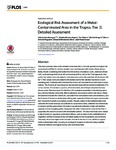Please use this identifier to cite or link to this item:
http://www.alice.cnptia.embrapa.br/alice/handle/doc/1028099Full metadata record
| DC Field | Value | Language |
|---|---|---|
| dc.contributor.author | NIEMEYER, J. C. | pt_BR |
| dc.contributor.author | MOREIRA-SANTOS, M. | pt_BR |
| dc.contributor.author | RIBEIRO, R. | pt_BR |
| dc.contributor.author | RUTGERS, M. | pt_BR |
| dc.contributor.author | NOGUEIRA, M. A. | pt_BR |
| dc.contributor.author | SILVA, E. M. da | pt_BR |
| dc.contributor.author | SOUSA, J. P. | pt_BR |
| dc.date.accessioned | 2015-11-06T11:11:11Z | pt_BR |
| dc.date.available | 2015-11-06T11:11:11Z | pt_BR |
| dc.date.created | 2015-11-06 | pt_BR |
| dc.date.issued | 2015 | pt_BR |
| dc.identifier.citation | Plos One, v. 10, n. 11, p. 1-25, Nov. 2015. | pt_BR |
| dc.identifier.issn | 1932-6203 | pt_BR |
| dc.identifier.uri | http://www.alice.cnptia.embrapa.br/alice/handle/doc/1028099 | pt_BR |
| dc.description | This study presents data on the detailed evaluation (tier 2) of a site-specific ecological risk assessment (ssERA) in a former smelter area contaminated with metals (Santo Amaro, Bahia, Brazil). Combining information from three lines of evidence (LoE), chemical (Chem-LoE), ecotoxicological (EcotoxLoE) and ecological (EcoLoE), in the Triad approach, integrated risk values were calculated to rank sites and confirm the potential risk disclosed with tier 1. Risk values were calculated for the habitat and for the retention functions in each sampling point. Habitat function included the ChemLoE calculated from total metal concentrations. The EcotoxLoE was based on reproduction tests with terrestrial invertebrates (Folsomia candida, Enchytraeus crypticus, Eisenia andrei), shoot length and plant biomass (Avena sativa, Brassica rapa). For the EcoLoE, ecological parameters (microbial parameters, soil invertebrate community, litter breakdown) were used to derive risk values. Retention function included the ChemLoE, calculated from extractable metal concentrations, and the EcotoxLoE based on eluate tests with aquatic organisms (Daphnia magna reproduction and Pseudokirchneriella subcapitata growth). Results related to the habitat function indicated that the metal residues are sufficient to cause risk to biota, while the low metal levels in extracts and the general lack of toxicity in aquatic tests indicated a high soil retention capacity in most sampling points. Integrated risk of tier 2 showed the same trend of tier 1, suggesting the need to proceed with remediation actions. The high risk levels were related to direct toxicity to organisms and indirect effects, such as failure in the establishment of vegetation and the consequent loss of habitat quality for microorganisms and soil fauna. This study shed some light on the selection of tools for the tier 2 of an ssERA in tropical metal-contaminated sites, focusing on ecological receptors at risk and using available chemical methods, ecological surveys and ecotoxicity tests. | pt_BR |
| dc.language.iso | eng | eng |
| dc.rights | openAccess | eng |
| dc.title | Ecological risk assessment of a metal-contaminated area in the tropics. Tier II: detailed assessment. | pt_BR |
| dc.type | Artigo de periódico | pt_BR |
| dc.date.updated | 2017-06-20T11:11:11Z | pt_BR |
| dc.subject.thesagro | Toxidez | pt_BR |
| dc.subject.thesagro | Contaminação | pt_BR |
| dc.subject.thesagro | Metal | pt_BR |
| dc.subject.nalthesaurus | Environmental assessment | pt_BR |
| riaa.ainfo.id | 1028099 | pt_BR |
| riaa.ainfo.lastupdate | 2017-06-20 | pt_BR |
| dc.identifier.doi | 10.1371/journal.pone.0141772 | pt_BR |
| dc.contributor.institution | JÚLIA CARINA NIEMEYER, UFSC; MATILDE MOREIRA SANTOS, University of Coimbra; RUI RIBEIRO, University of Coimbra; MICHIEL RUTGERS, RIVM - The Netherlands; MARCO ANTONIO NOGUEIRA, CNPSO; EDUARDO MENDES DA SILVA, UFBA; JOSÉ PAULO SOUSA, University of Coimbra. | pt_BR |
| Appears in Collections: | Artigo em periódico indexado (CNPSO)  | |
Files in This Item:
| File | Description | Size | Format | |
|---|---|---|---|---|
| 2015PLOSONENiemeyeretal.pdf | 488.65 kB | Adobe PDF |  View/Open |









